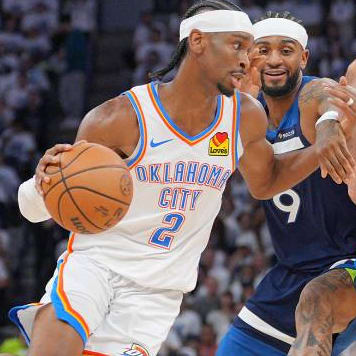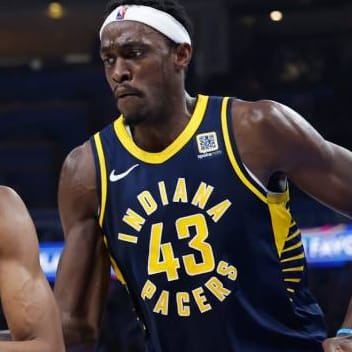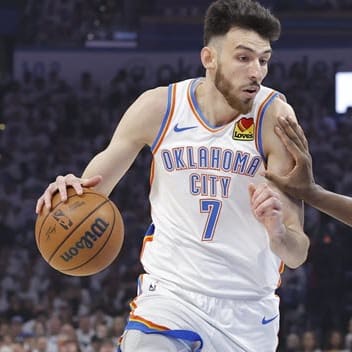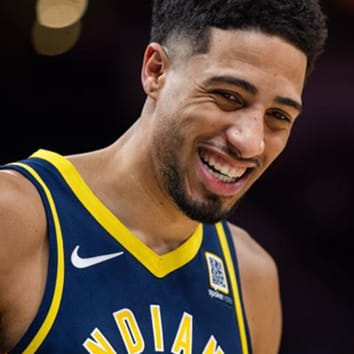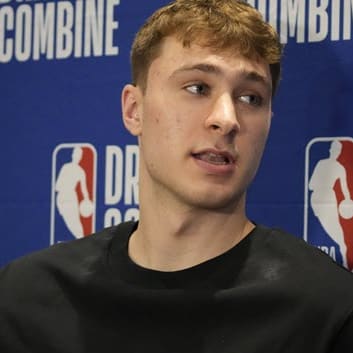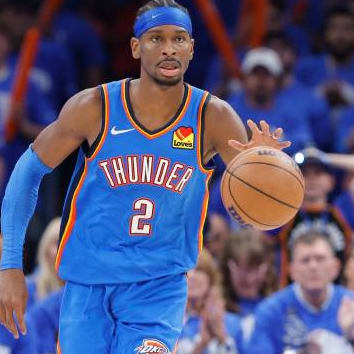This article is part of our The Give and Go series.
The Give and Go
By Charlie Zegers and Carson Cistulli
RotoWire Staff Writers
From: Carson Cistulli
Sent: Monday, February 1, 2010 8:32 PM
To: Charlie Zegers
Subject: Give and Go: Solving for X
It's become more or less the rule in real-live NBA basketball: when you draft, draft the best player available and work things out from there -- by means of trade or whatever -- to craft the ideal roster. That way, you don't accidentally end up with a giant, inert Serbian instead of one of the game'sbestplayers. Of course, some teams will never learn (Memphis Grizzlies, I'm looking at you), but generally speaking, the smart teams either take the best remaining player or trade their draft pick if they really aren't impressed with the available talent.
I try to approach my fantasy basketball drafts in roughly the same way -- namely, to pick the best available fantasy talent and let them go at it for the first X months of the season. Of course, I pay some attention to positions -- I don't pick, like, seven centers or whatever -- but I tolerate a little imbalance if I think it'll get me the greatest possible production overall.
Of course, just because such a strategy is probably the best way to begin a season, it's not necessarily the best way to finish it. The truth is, there are categories to consider, and at some point -- whether it's sooner or later -- the fantasy owner has to adjust to his team's standing within these categories.
Like recently, I've found myself in a position where my points-scored standing for the season is almost entirely secure. I'm currently in second place. The team ahead of me has like a thousand more points scored than me; the team behind, about a thousand fewer. Therefore, at this point, rating players on the basis of their scoring abilities is almost entirely meaningless. Sure, a guy who takes more shots will have an effect on my FG% -- a category in which I'm still trying to create forge some distance between myself and the nearest competitor -- but they're still separate categories and don't correlate perfectly.
As a result, I've found myself valuing players only on the basis of seven categories. Points Scored just isn't a consideration now. The effects are substantial. Regard: Using Basketball Monster's player rankings for a league my size (10 teams, 17 players each), here are the top-10 players:
- LeBron James
- Chris Paul
- Kevin Durant
- Carmelo Anthony
- Kobe Bryant
- Dirk Nowitzki
- Dwyane Wade
- Steve Nash
- Chauncey Billups
- Danny Granger
Now, doing the same thing without Points Scored:
- Chris Paul
- LeBron James
- Kevin Durant
- Jason Kidd
- Steve Nash
- Chauncey Billups
- Gerald Wallace
- Rajon Rondo
- Dirk Nowitzki
- Marcus Camby
With that in mind, I recently traded Monta Ellis away for Marcus Camby. Counting Points, Ellis and Camby are ranked 12th and 33rd, respectively. Without Points, the tables are basically turned: Ellis drops to 30th, Camby rises to 10th. Presumably, the opposition owner was happy with his takeaway. I certainly was.
Here's my thing, though: I'm not exactly sure when to make my run on certain categories. You'll notice up above there, I wrote simply "X" months. What's the "X"? is my question. Have you made your runs at certain cats yet? How big a gap is too big? When is a lead safe?
Riddle me that, Zegers.
From: Charlie Zegers
Sent: Tuesday, February 2, 2010 6:49 AM
To: Carson Cistulli
Subject: Give and Go: Solving for X
Interesting question, sir. I shall answer it by asking a series of additional questions.
(Some call this "The Socratic Method." I prefer to think of it as "covering up when I don't actually know the answer.")
The first consideration is, "which categories, and how far behind are you?" Our RotoWire compadre Chris Liss has a theory that it is more difficult to make up ground in percentage stats late in the season. He reasons that far too many fantasy NBA teams are abandoned late in the year, and the owners who wind up with an active roster heavy on inactive players will fall behind in counting categories, but their percentages will stay the same. Chris often suggests drafting for percentages and trying to make up ground in the other categories.
If you believe Chris is right about that, it makes sense to start making adjustments in percentage categories sooner. For "counting" stats - rebounds, steals, blocks, etc., you probably have a little more time.
Another important consideration is, "why is your team lagging in category X?"
Maybe you built a team around Dwyane Wade, whose early-season shooting woes have been well-documented. I don't own Wade in any leagues -- I didn't have a high enough pick in any draft this year - but if I did, I wouldn't be THAT concerned. Wade's struggles seem to be a bit of a fluke and based mostly on shot selection.
Or to use an example from my own team - I drafted Corey Maggette in a couple of leagues, mostly because he's a high-volume free-throw shooter, and he hits those freebies at a remarkably high rate. Through November, he was at 76 percent - good for lots of forwards, but certainly not what I had in mind. But I didn't panic - his value in that category is well-established, and there was no reason not to expect a turnaround. And as I'm writing, his number for the season is just shy of 85 percent.
On the other hand, I'm not at all convinced that Vince Carter will start playing to his career norms. He doesn't seem to fit well with Orlando's rotation, and a nagging shoulder injury certainly isn't helping. Players waiting for Carter to turn things around might want to consider alternate strategies.
Then there's "how deep is your league?" In shallow leagues, it's fairly easy to find help on the waiver wire, particularly if you need a one-or-two category specialist to make up some ground. For example, "Birdman" Chris Andersen is ninth in the league in blocks, but he's available in about half the leagues hosted on Yahoo!, and Ronnie Brewer - tenth in the league in steals - is 59 percent-owned.
Of course, sometimes you just make a gross miscalculation on draft day. Case in point: heading into this season, I thought the Sixers would be a good offensive team. And I backed up that theory by investing heavily in players like Andre Iguodala, Lou Williams, Thaddeus Young and Marreese Speights. I don't have to tell you how well that's worked out. With Eddie Jordan now in "throwing darts at a roster sheet to determine lineups" desperation mode, I have zero faith that any of those players right now. Problem is, neither does anyone else… so trades are pretty much out of the question.
Obviously, it's time to make roster adjustments - but how do you deal with a player like Williams, who has too much talent to simply drop in most leagues but who isn't playing well enough to merit a roster spot?
From: Carson Cistulli
Sent: Wednesday, February 3, 2010 2:26 PM
To: Charlie Zegers
Subject: Re: Give and Go: Solving for X
Okay, Zegers, I'll play your little Socratic game. One question, though: Do I really have to wear this toga?
Your questions, my answers:
1. "Which categories, and how far behind are you?"
Is it me, or does Chris Liss have wisdom just flowing out of him. (At least, that better be wisdom. Otherwise, ick.) He's like the flipping Obi-Wan of fantasy sports.
If I'm being frank with you, I have to say I've never considered the Case of the Abandoned Fantasy Team as it related to percentages, but point taken. I'll adjust accordingly as I approach draft day next year. Luckily, it's not really a consideration in the league I was discussing, which, in addition to being a keeper league, also has a contract system that stimulates late-season player movement. So some teams give up, yes, but they're typically looking to make dump-style trades when they do it.
The category I was failing hardest in -- 7th out of 10 teams -- was rebounds. I've addressed it by -- duh -- adding guys who can rebound: LaMarcus Aldridge and Marcus Camby, most notably. Camby's a great fit for my team, as Points Scored isn't really a consideration now. Aldridge probably isn't one of the great rebounding power forwards in the league today, but he's also no worse than Juwan Howard, who's been getting the bulk of minutes at center in the absence of Gred Oden and Joel Przybilla. Somebody has to grab the rock.
2. "Why is your team lagging in category X?"
Probably the most glaring reason is simply due to how I was utilizing my four Flex spots. Below are the my Flex spots for the first ten weeks of the season.
- Danilo Gallinari, Shawn Marion, Martell Webster, Lou Williams
- Ronnie Brewer, Grant Hill, Marion, Williams
- Brewer, Hill, Carl Landry, Marion
- Landry, Marion, Luc Richard Mbah a Moute, Thabo Sefolosha
- Monta Ellis, Luke Ridnour, J.R. Smith, Sean Williams
- Roy Hibbert, Marion, Ridnour, Jamaal Tinsley
- Jerryd Bayless, Brewer, Jarrett Jack, Marion
- Brewer, Jack, Marion, Nene
- Hibbert, Nene, Landry, Paul Pierce
- Donte Greene, Landry, Nazr Mohammed, Tyrus Thomas
I'll give you a second to finish laughing at some of those pick-ups. Sean Williams? Nazr Mohammed?
Okay, now stop.
Seriously, stop.
Thank you.
Anyway, it's clear what I was trying to do with those picks -- namely, to balance out the smaller lineups I'd been playing. By my count, of the 40 players I played in my Flex spots over the first 10 weeks, there were 15 guards, 19 forwards, and only 6 centers. And that's counting Sean Williams as a center. If you consider the distribution of the main roster spots in this league -- 3 G, 3 F, 2 C -- and adjust that proportionally to a "roster" of 40 instead of only eight, that would come out to 15 G, 15 F, and 10 C. My lineup ended up being productive in other areas, but I needed to address the rebounding situation eventually.
3. "How deep is your league?"
I'm really tempted to to pull out a Michael Scott-esque "That's what she said" right here. I don't know exactly how it relates to the question, but it seems dirty, and I'm therefore satisfied.
As I mention above, the league in question is 10 teams. One thing that's a little bit weird is the number of rosterable players one is allowed: 12 active, 6 bench, and 3 injured. So even though there are only 10 teams, the number of freely available talent is somewhat limited. I've gotten some deals off the waiver wire (Nicolas Batum! Nicolas Batum! Nicolas Batum!), but the more talented players have come by and large via the trade.
4. The Lou Williams Paradox
So you have a player that you considerable valuable at some level but who (a) isn't currently productive enough to include in you lineup and (b) doesn't appeal to other owners as a trade commodity.
Harumph, is my main answer to that. And also: I've been there. I guess eventually it comes down to how much you value your bench spots. There are a number waiver wire players who actually provide quite a bit of value in a four-game week. This week, for example, I have both Rudy Fernandez and Nicolas Batum going over three-gamers like Shawn Marion and Danilo Gallinari. Thing is, I couldn't do that sort of thing if I didn't have a certain amount of roster flexibility.
Questions:
- Have you tried to trade Williams? If so, for whom?
- How much investing do you do in four-gamers?
- In re the Flex or Utility spots, do you have techniques for maximizing them?
From: Charlie Zegers
Sent: Wednesday, February 3, 2010 1:07 PM
To: Carson Cistulli
Subject: Give and Go: Solving for X
The depth of the player pool is an important consideration in any fantasy league. In super-deep AL-only fantasy baseball leagues, you need to know if the fifth outfielder on the Tigers actually plays more than once a week. In NFL leagues that start two quarterbacks, you might have to think about having to start DeMarcus Russell or Alex Smith on the bye week. In shallow NBA leagues, you might use the sixth man in some team's rotation - deep leagues might use the eighth and ninth guys.
For the purposes of this discussion - in a shallow league, you can probably find players on the wire to juggle and "fill in" your team's weak categories. In a deeper league, that's a lot harder to manage.
As for your questions...
Have I tried to trade Williams? No… partly because I'd be selling SO low, and partly because I do think there's a legit chance that Iguodala will be traded.
Do I chase four-gamers? No, but only because I'm not in any weekly transaction leagues this year.
As far as flex spots are concerned… that's an interesting question. When I first started playing fantasy games, I made a mistake that's probably familiar to a lot of players - building my roster as if it was an actual team. I'd work to get five good-to-great "starters" and then fill in the flex positions as if they were my bench. The problem with thinking that way is that, when scores are tallied, there's not a bit of difference between the numbers accumulated by a flex, a "guard" and a PG. Fill the spots where eligibility actually matters, but just play your top guys.
I think it's handy to have some "multiple position" guys in the flex spots and the bench because it gives you the flexibility to use a lot more combinations of players depending on matchups and injuries and whatnot. My team in the Yahoo! Friends and Family league is a bit of an extreme case; out of fourteen roster spots, the only single-position players I've got are Deron Williams, Mo Williams and Kendrick Perkins.
Unfortunately, the injury to Mo Williams hit my thinnest position. I'm loaded with four/five types, but guard has been a problem in that league all year. Right now, after the Williamses, my options are Luol Deng (SF/SG), Chris Douglas-Roberts (PG/SG/SF) and Rasual Butler (SG/SF).
And yes, I did tell you I'm carrying CDR - in an expert league, no less - to make you feel a little better about that whole Sean Williams thing.
From: Carson Cistulli
Sent: Thursday, February 4, 2010 3:05 AM
To: Charlie Zegers
Subject: Re: Give and Go: Solving for X
So, more or less in the course of the present correspondence, let me tell you what's happened.
Regard:
- Carmelo Anthony (ankle) has missed Monday and Wednesday.
- Paul Pierce (foot) missed Wednesday night's game and has been ruled out for Friday.
- Carlos Boozer (calf) has missed Monday and Wednesday.
- Chris Kaman (ankle) has recorded consecutive double-doubles.
What's the relevance here? Well, they're all on my team, for one. And for two, with the exception of Boozer, I rostered them all backwardsly*.
*Yes, it's a word. No need to look it up.
Anthony I figured was a lock to play this week. His original diagnosis had him missing only one game. Yeah, that turned into two and then three and then four, but reports out of Denver had him rejoining the starting lineup for Monday. Instead, he's missed both games this week so far. Argh.
Paul Pierce somehow strained his "mid-foot" against Washington on Monday. I didn't even know there was such thing as a mid-foot. I mean, I'm not a doctor, but I know some doctors and they've never said word one about any "mid-foot." Double-argh.
And then Chris Kaman -- well, I figured with his injury history and all that he was the most likely to miss games this week. Well, he didn't. Instead, he decided to rebound the flip outta the ball. Argh times a hundred.
What am I aiming to prove here, Zegers? Probably nothing. It's probably that I'm mostly complaining.
But were I to begrudgingly cobble together a moral to this sad, sad story, it'd be that -- to paraphrase Robert Burns -- that our best laid schemes often go awry. In other words, talk about maximizing the usage of your Flex spots all you want -- if Carmelo Anthony isn't playing, that's kinda a bummer. Of course, that doesn't mean we shouldn't make the plans in the first place. It just means that only the process, as opposed to the product, is within our hands.
C'est la vie to the max!
Article first appeared on 2/4/10






